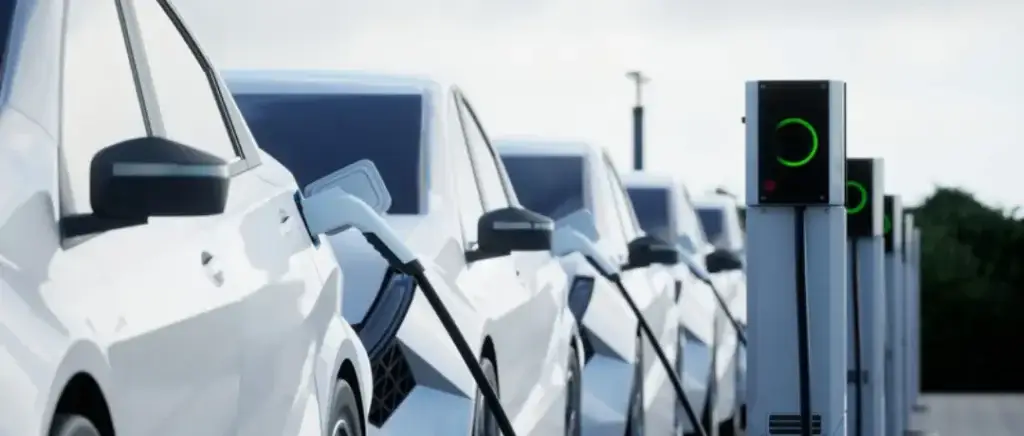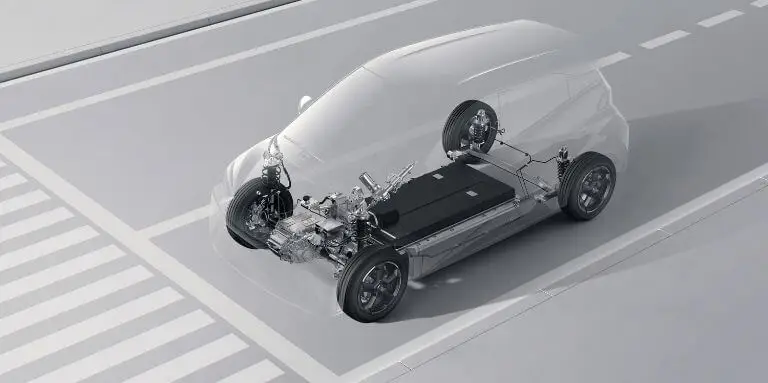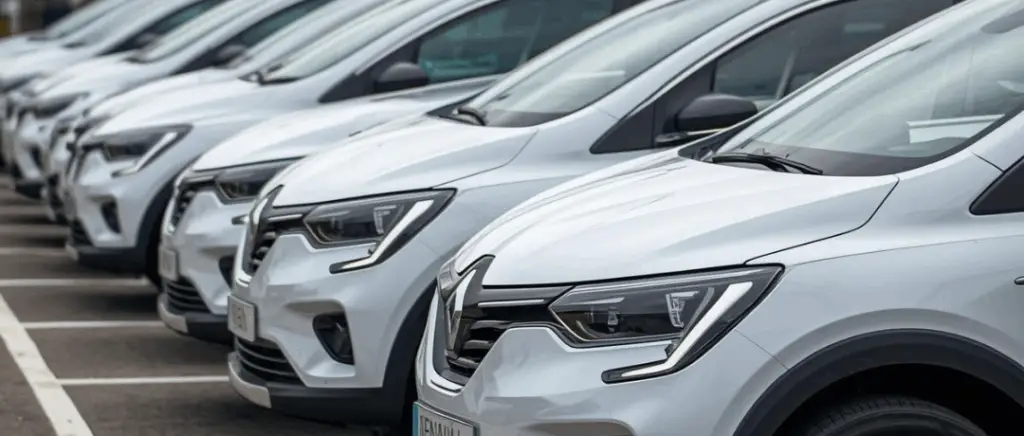Why is battery management crucial to the sustainability of an electric vehicle fleet?
La battery is the beating heart of the electric vehicle. Without it, energy cannot be stored or delivered.
Did you know that the first electric vehicles, at the beginning of the 20th century, were already equipped with them? They were powered by lead batteries. But their autonomy and the rapid development of the combustion engine pushed them into the background for several decades.
We had to wait until the years 1990-2000 to see the reappearance of a truly competitive solution:
the lithium-ion battery. Its much higher energy density than older lead-acid batteries
has made it possible to considerably improve the range of electric vehicles and, at last, to envisage their large-scale deployment.
In the near future, the new generation of "solid" or lithium-ion batteries promises even higher energy density and lower power consumption. range of over 1,000 kilometres !
On average, a lithium-ion battery has a lifespan of 8 to 10 years, and can withstand around 1,500 to 2,000 full recharging cycles. However, this lifespan is not set in stone: it can vary considerably depending on various parameters, such as storage and usage conditions, as well as your driving and recharging habits.
As you can see, batteries are essential components of your vehicles. Preserving them means ensuring the longevity of your electric fleets.
Converting your fleet to electric: the complete guide
How can you effectively plan battery recharging to reduce costs and downtime?
Reload at the right time, at the best priceand according to real needs of your fleet: that's the key to efficient management. Good planning both reduces electricity bills and ensures that your vehicles are always available, when you need them.
Recharging at off-peak times
The first best practice is to give priority to charging during off-peak hours. With a "peak/off-peak" contract, you benefit from a preferential rate, generally applied at night. In concrete terms, as of 1 August 2025, electricity costs €0.1952 incl. tax/kWh under the basic option, compared with €0.1635 incl. tax/kWh under the off-peak option. This represents a saving of almost 16 % on each recharge. A considerable gain on the scale of a fleet of vehicles!
(source : EDF)
Use an intelligent management system
Connected recharging stations make it much easier to planning refills of your electric fleet. Linked to a mobile application, they enable you to schedule charging sessions at the most opportune times: at night, when your vehicles are not in use. Some vehicle-integrated applications even offer advanced options such as deferred charging or weekly programming, ideal for efficient remote control.
What technological tools can be used to monitor and optimise the condition of batteries in real time?
The battery is not just a reservoir of energy: it's a complex system that needs constant monitoring. Various technological tools can be used to monitor its condition and optimise its performance on a daily basis.
The systems BMS (Battery Management System)
In the event of an anomaly (overheating, overvoltage or undervoltage), the BMS automatically takes protective measures to prevent damage to the battery.
The data collected is transmitted to the vehicle and displayed on the dashboard or central screen.
The driver can follow :
- the state of charge, i.e. the remaining battery level;
- Battery life data, in particular the number of Ah (ampere hours) delivered and life cycles;
- alerts generated by the deactivation of certain functions.
External monitoring solutions
Alongside these integrated systems, complementary tools such as EVNotify make it possible to retrieve all this data remotely.These applications are particularly useful for fleet managers, who need to keep a constant eye on the energy status of their vehicles.They allow you to check estimated autonomy and battery temperature in real time, and receive personalised alerts when a critical threshold is reached.
These solutions make it easier to take the right decisions, such as scheduling a recharge, immobilising a vehicle in the event of a problem or optimising fleet rotations.
How can telematics improve battery life in a fleet of electric vehicles?
Telematics applied to batteries is an intelligent monitoring system that continuously monitors and analyses their condition, performance and conditions of use. In practical terms, it collects data such as charge level, temperature and wear and tear, then transmits it to a platform hosted in the cloud.For fleet managers, telematics is an essential management tool that enables them to :
- monitor battery health in real time,
- receive personalised alerts in the event of an anomaly,
- anticipate needs thanks to predictive maintenance.
This approach makes it possible to detect signs of failure very early on (overheating, reduced capacity, too frequent cycles) and to take action before a vehicle breaks down. The result: less downtime, greater safety and batteries (and therefore vehicles) that last longer!
Telematics also benefits vehicle manufacturers (OEMs), who gain access to invaluable data on how batteries behave in real-life conditions. This information enables them to improve future models and offer even more effective monitoring services.
Simply compare and find the vehicle that's right for you
What strategies should be adopted to avoid premature degradation of electric vehicle batteries?
Avoid deep discharges
Lithium-ion batteries work at their best when they remain within a certain charge range. between 20 % and 80 %. Emptying them completely or overcharging them to 100 % accelerates their ageing. On a daily basis, it's better to opt for regular partial recharging rather than full recharging. Good to know: some charging stations incorporate management systems that allow you to set a maximum charge level, thereby preserving the life of your batteries.
Regularly maintain your electric vehicle
Good maintenance contributes directly to energy efficiency and therefore to the preservation of the battery. Annual maintenance, which is simpler and less costly than that of an thermal vehicleThis includes checking the electronic equipment, the recharging system and the traction battery.
Our advice: make your Car Policy a reference document in which the servicing and maintenance procedures for electric vehicles are explicitly detailed.
Protect the battery from extreme temperatures
Excessive heat and intense cold can lead to premature degradation of the battery. A few precautions can limit these effects: park in the shade in summer, use a closed car park in winter or activate the thermal pre-conditioning systems available in most recent models.
How can predictive maintenance be integrated to anticipate battery-related needs?
La predictive maintenance enables problems to be anticipated before they affect vehicles. By continuously analysing battery performance trends - charge level, discharge cycles, temperature or variations in efficiency - it becomes possible to spot the warning signs of failure.
Thanks to artificial intelligence and machine learning, the data collected can be analysed in even more detail, to detect operating anomalies and anticipate maintenance requirements with even greater precision.
The fleet managers can plan interventions and avoid unexpected breakdowns. Early warnings also help to protect batteries from over-aggressive use or adverse conditions.
What are the best practices for optimising vehicle autonomy and fleet energy management?
To optimise the range of your electric vehicles and, by the same token, the energy efficiency of your fleets, it's often the drivers who need to be looked at.
Adopting eco-driving
Eco-driving is about adopting a more responsible and energy-efficient approach to driving. A few simple gestures can make a big difference:
- Anticipate braking: by releasing the accelerator rather than braking suddenly, the car recovers kinetic energy in the form of electricity and stores it in the battery. Planning your stops and decelerations therefore increases your range.
- Adapt your speed: driving at a moderate, constant speed reduces fuel consumption and conserves the battery.
Do not overload the vehicle
Rationalising the use of heating and air conditioning
In an electric vehicle, heating and air conditioning consume electrical energy directly. Using these systems at full throttle would represent a loss of up to 10 % of range. Here are a few tips to help you adopt good habits:
- Pre-heat or pre-cool the passenger compartment before setting off.
- Favour heated seats or a heated steering wheel, which consume less energy.
- Adjust the temperature: 2°C less on the air conditioning or 2°C more on the heating can make a significant difference to overall consumption.

How can the size of the fleet be sized and adapted to suit usage and battery capacity?
The first step in sizing your fleet is to clearly define your objectives: what is the role of each vehicle, how can performance be measured and what are the trade-offs or constraints (budget, range, recharging time)?
| Fleet usage | Recommended autonomy | Battery capacity | Benefits |
|---|---|---|---|
| Short-distance commuting | ~300 km | ~40 kWh (≈ 220-240 Ah) | Ideal for urban travel and short journeys, with reduced costs and energy consumption |
| Occasional journeys over longer distances | ~400 km | ~50 kWh (≈ 270-300 Ah) | Balanced autonomy and budget, suitable for most business needs, infrequent recharging |
| Intensive use for mobile professionals | ~600 km | ~75 kWh (≈ 400-420 Ah) | Regular long-distance journeys, maximised performance and availability, fewer recharging constraints |
Focus on the turnover rate
The turnover rate corresponds to the frequency with which a vehicle is used and recharged. To size the fleet correctly, it is crucial to know how many daily journeys each vehicle makes and how much time it can be immobilised for recharging sessions.
What are the key criteria for choosing the right recharging infrastructure for your electric fleet?
The choice of charging stations must be adapted to the battery capacity of the vehicles in your fleet. A charging point that is too powerful for a small battery can generate unnecessary extra costs, while an undersized charging point will extend the recharging time and immobilise vehicles for longer.
The aim is therefore to finding the right balance To optimise charging times, reduce energy costs and guarantee fleet availability.
How can intelligent route management help to preserve batteries?
A intelligent route management reduces energy consumption and preserves battery life by optimising every journey.
Anticipating daily journeys
Daily route planning is essential to limit unnecessary consumption and avoid deep discharges.
Use advanced planning tools
Software and algorithms for route planning take into account multiple parameters: vehicle range, availability of charging points, real-time traffic and operational constraints. These tools help to optimise journeys while reducing battery wear and tear.
Integratingrecharging infrastructure in planning
Taking into account the charging points installed in your car parks, and more specifically their power, is crucial. The more powerful the charging points, the faster they recharge and the less time vehicles spend idle. By taking these parameters into account, you can avoid range-related stress, reduce waiting times and ensure more efficient journeys.
Summary table
| Objective | Solution / Best practice | Result / Benefit |
|---|---|---|
| Ensuring the durability and longevity of batteries | - Keep the load between 20-80 % - Regular battery maintenance - Protect against extreme temperatures | Long-lasting batteries, reliable fleet, lower costs |
| Reduce recharging costs and maximise availability | - Schedule off-peak charging - Optimising the load according to actual needs | Lower electricity bills, available vehicles |
| Anticipating failures and preventing breakdowns | - Cloud telematic tracking - Predictive maintenance with personalised alerts | Fewer breakdowns, greater safety, longer batteries |
| Optimising autonomy and energy efficiency | - Practising eco-driving - Limiting overloads - Adapting heating/air conditioning | Maximum range, reduced fuel consumption, preserved comfort |
| Adapting the fleet to usage | - Sizing batteries and range according to routes - Tracking turnover | High-performance fleet, optimised costs, guaranteed availability |
| Reduce recharge times | - Choosing the right terminals for the battery capacity | Fast charging, less downtime |
| Minimising fuel consumption on journeys | - Plan itineraries according to autonomy and terminal availability | Optimised journeys, preserved batteries, greater efficiency |
































